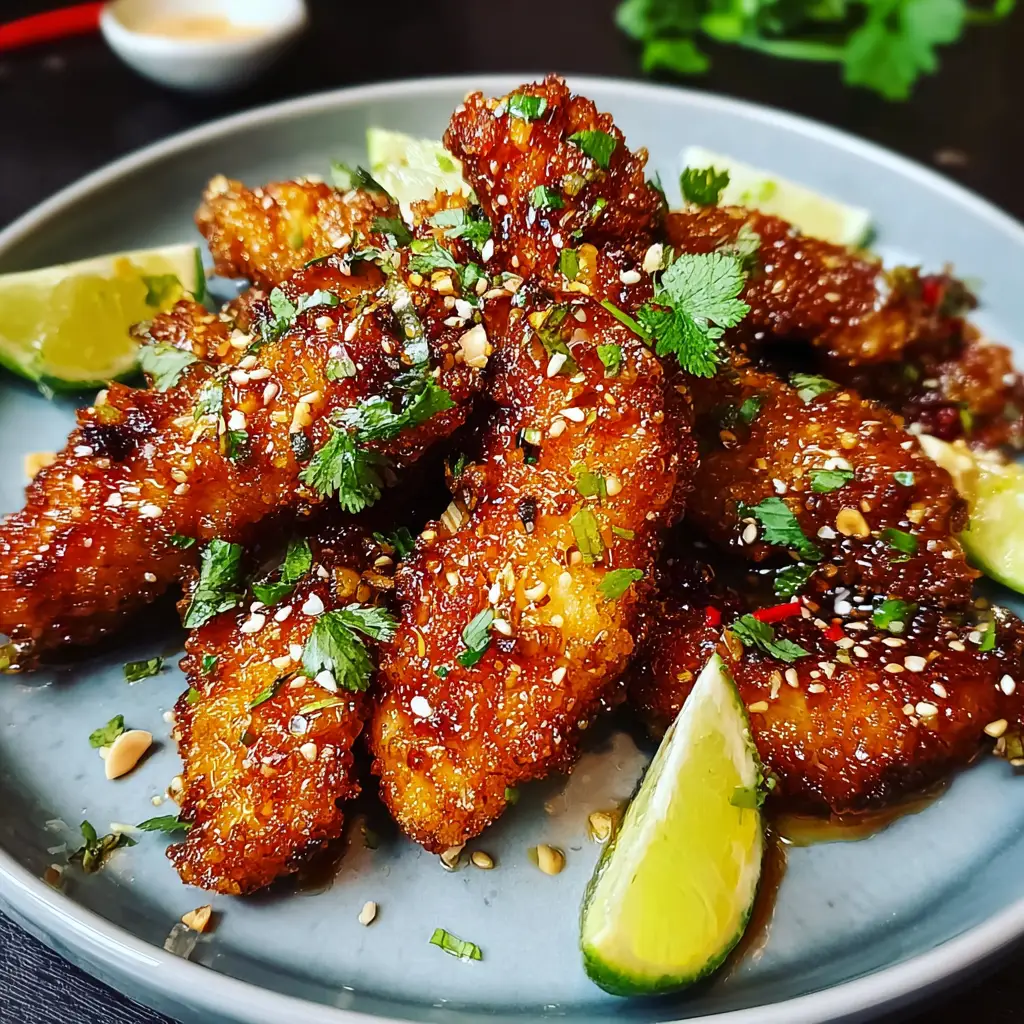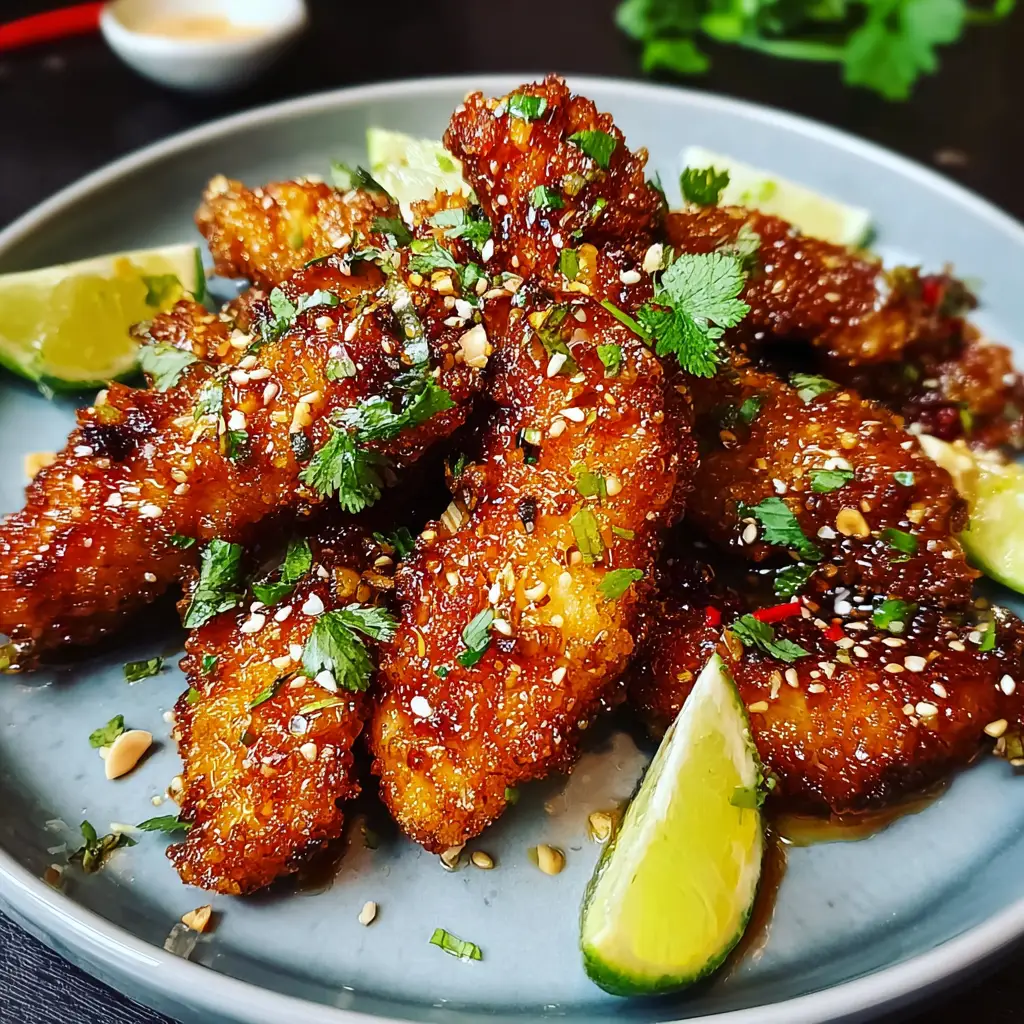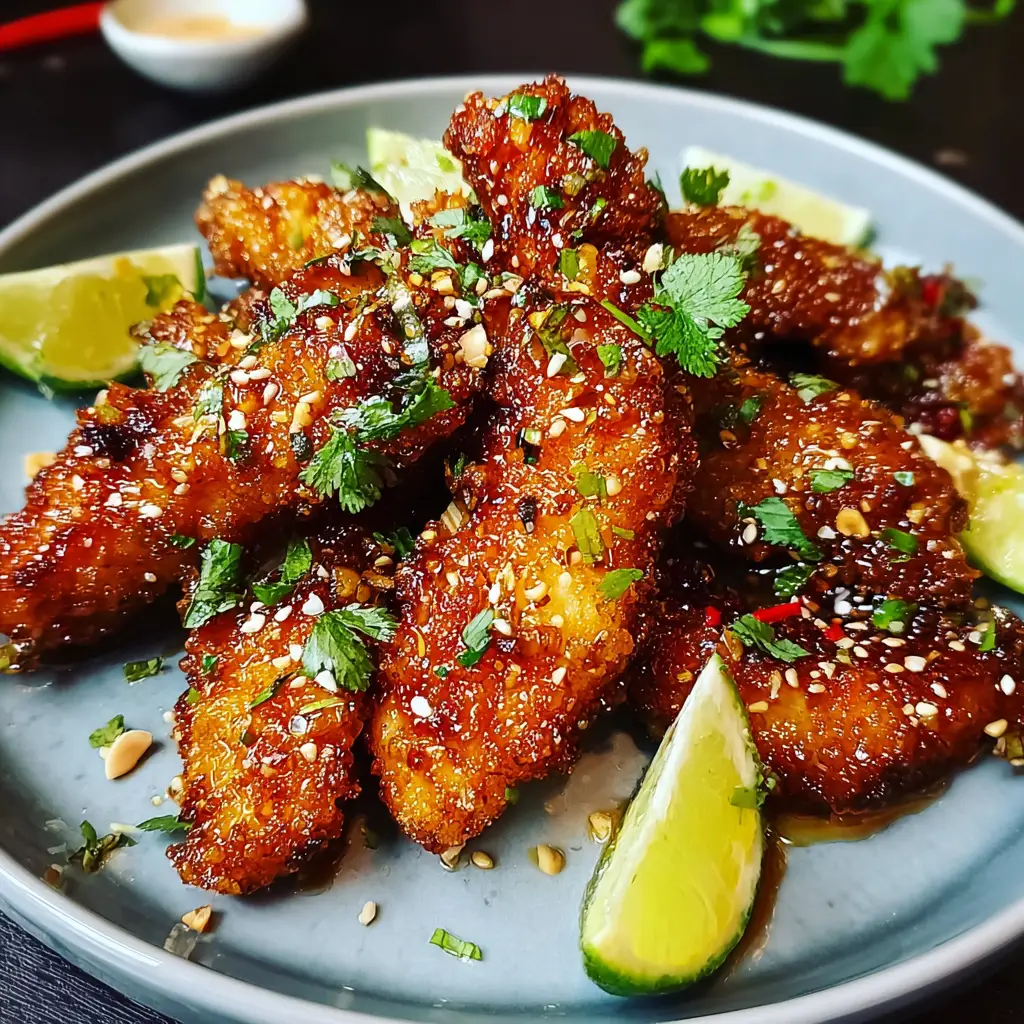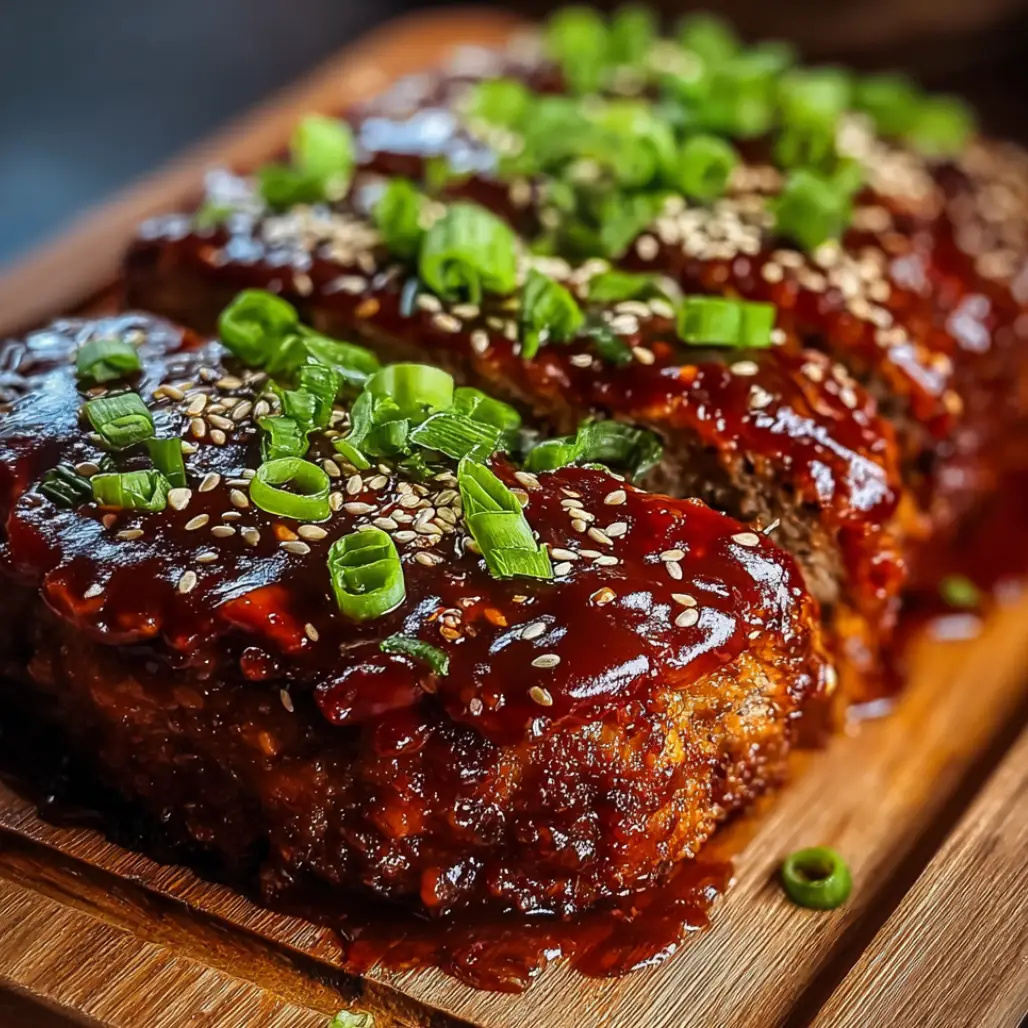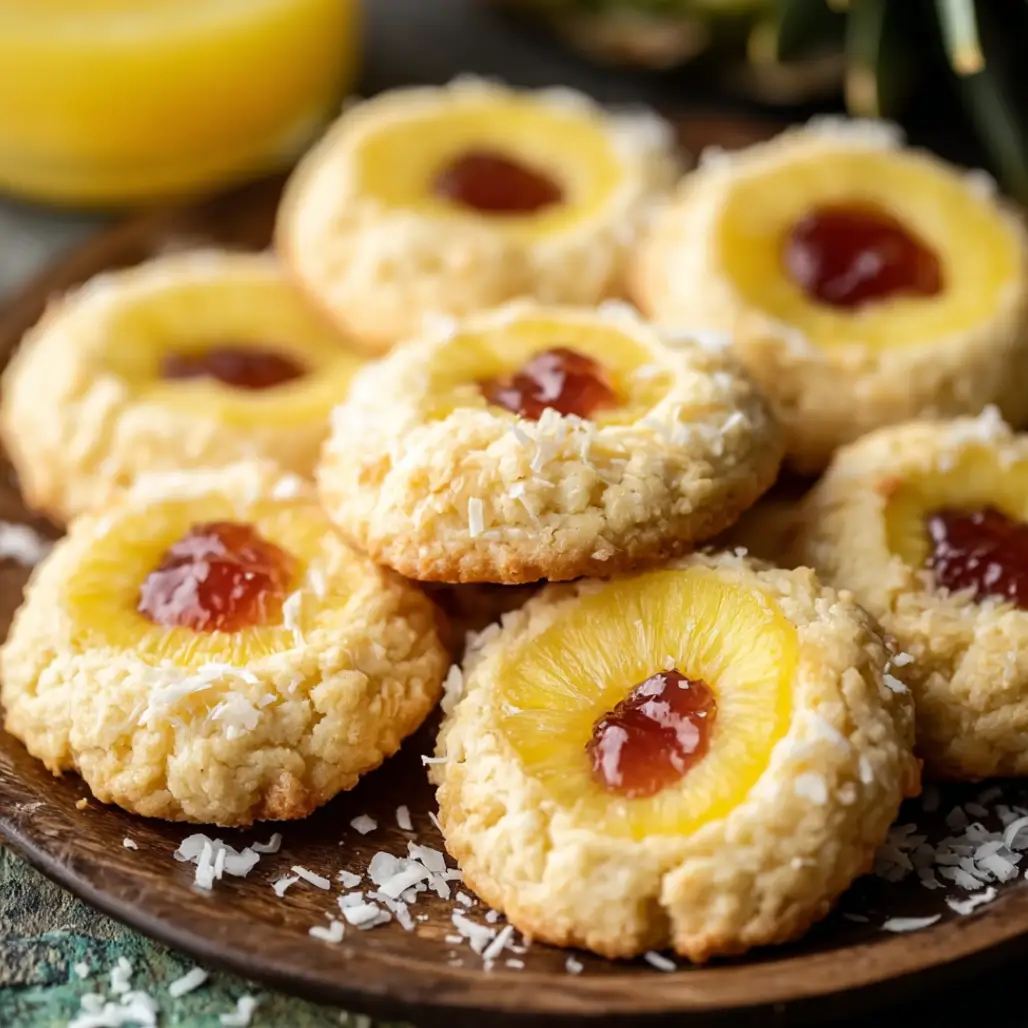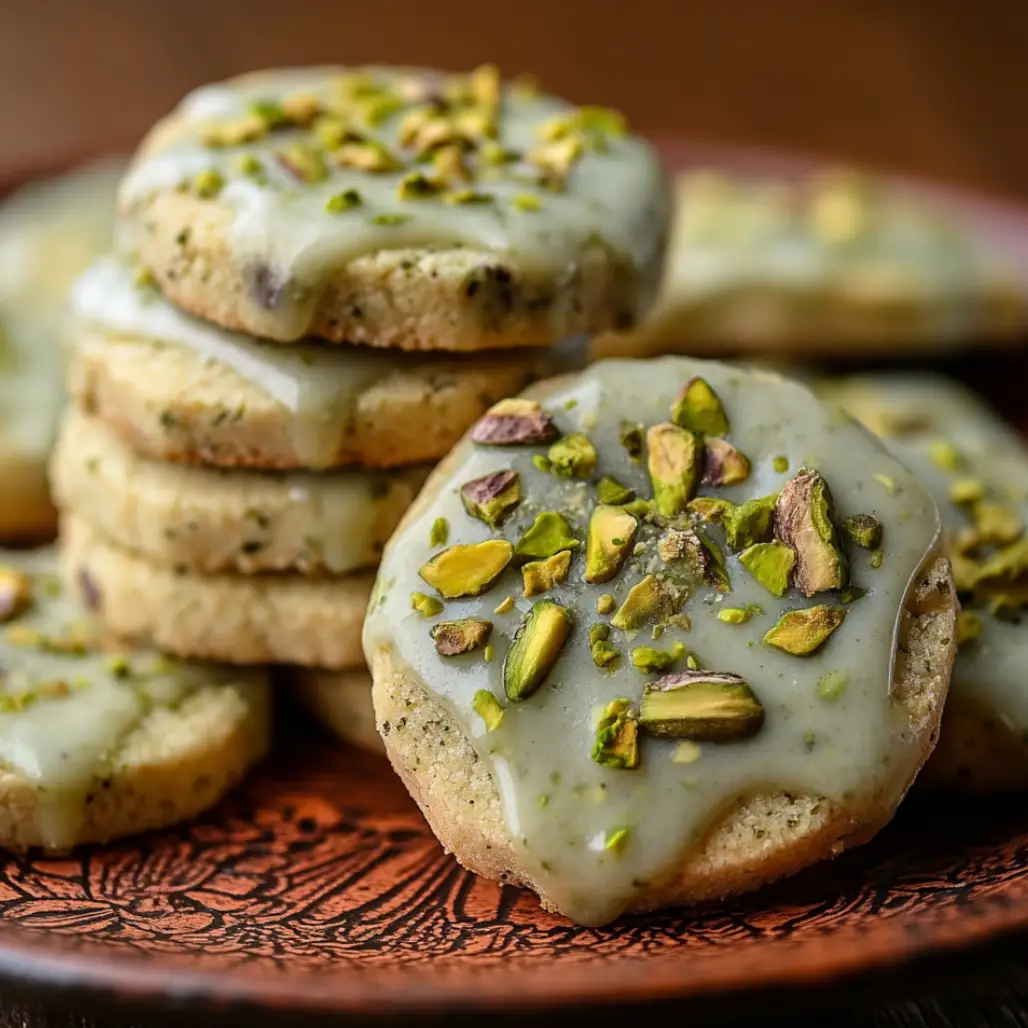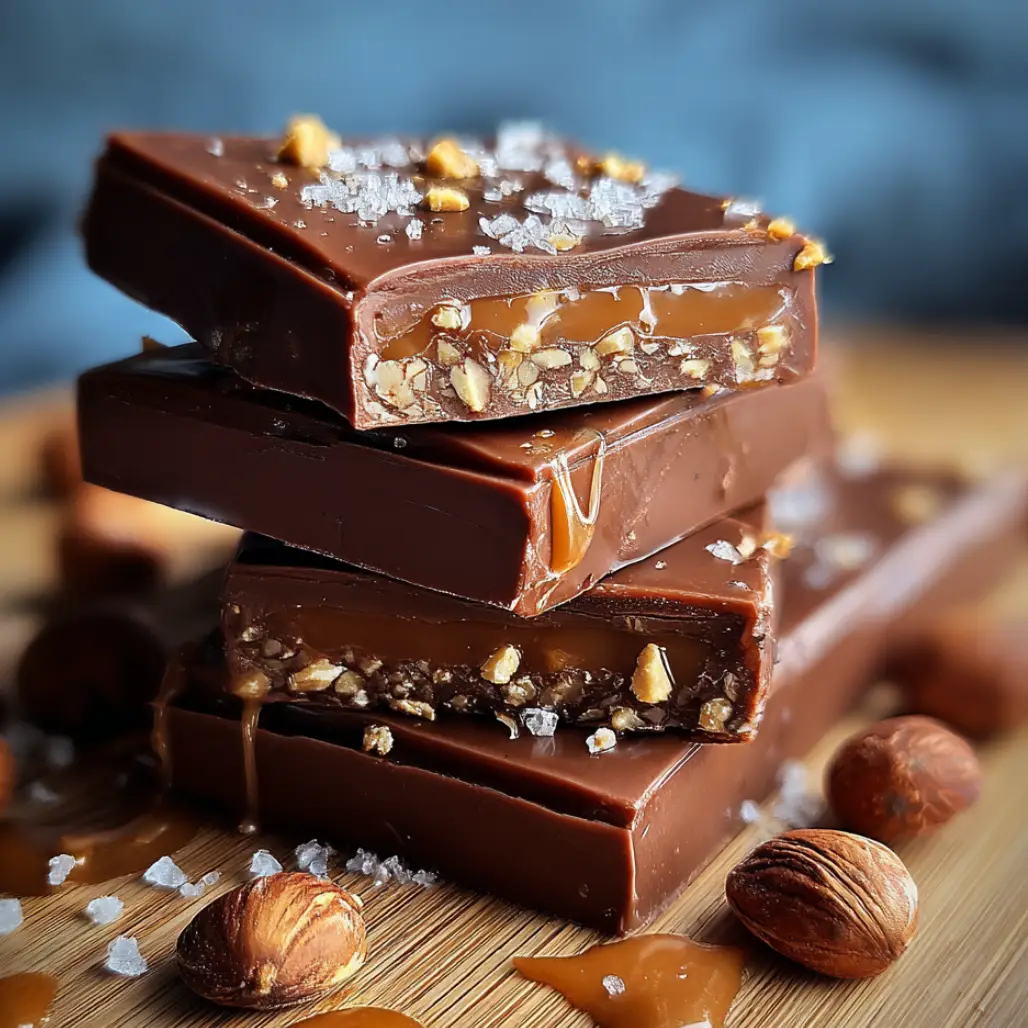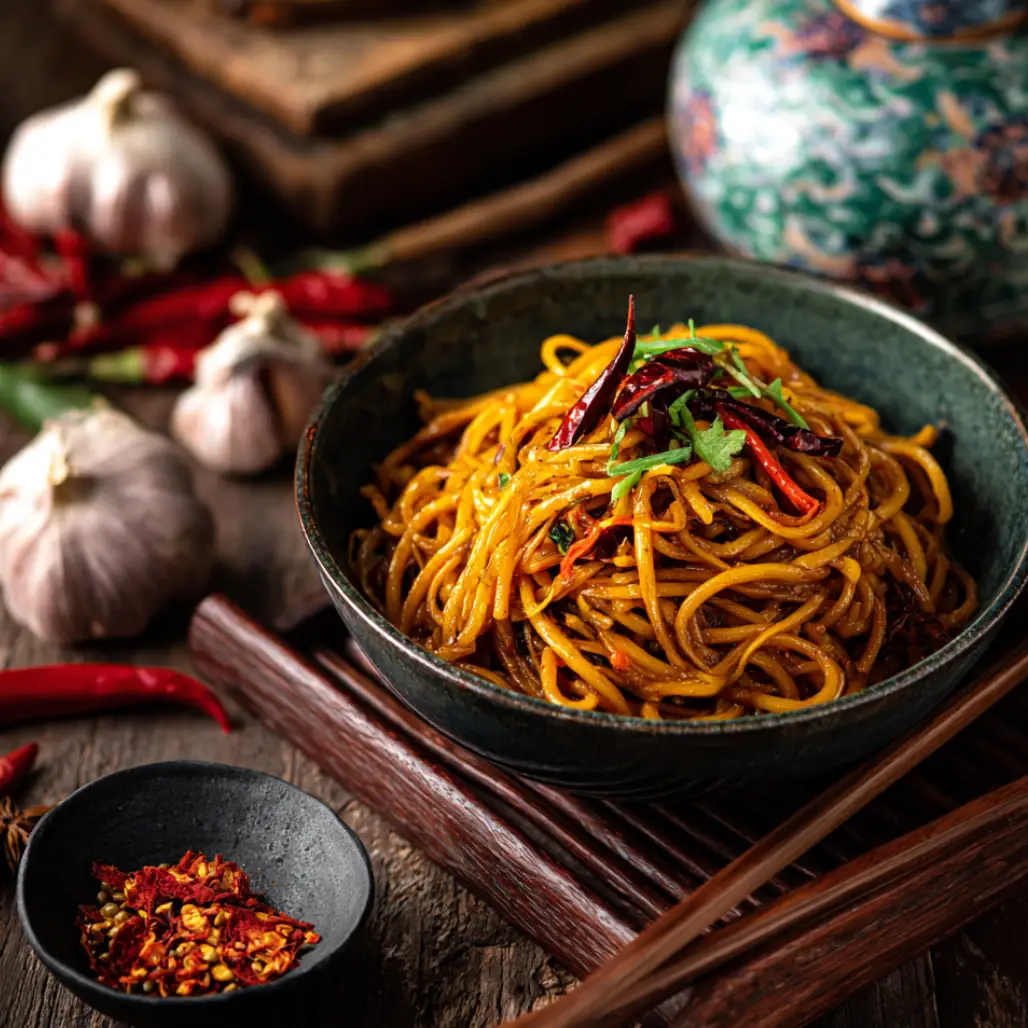| Prep Time: 25 minutes | Cook Time: 25 minutes | Total Time: 50 minutes | Serves: 4-6 |
|---|
Why Thai Sticky Chicken Fingers Deserve Your Kitchen Attention
Thai sticky chicken fingers represent the perfect marriage of familiar comfort food techniques with bold international flavors because they satisfy our universal craving for crispy, handheld foods while introducing adventurous eaters to the complex flavor profiles that make Thai cuisine so captivating and memorable. Unlike traditional chicken fingers that rely solely on familiar seasonings, these elevated strips showcase the beautiful balance that defines authentic Thai cooking, where sweet elements harmonize with spicy heat, tangy acids complement rich umami notes, and aromatic herbs provide fresh counterpoints to deeper, more intense flavors.
The visual appeal of these golden-brown beauties cannot be overstated because the glossy, mahogany-colored glaze creates an almost lacquer-like finish that glistens invitingly under kitchen lights and promises the sticky-sweet satisfaction that awaits with every bite. The contrast between the textured, crunchy exterior and the glossy sauce creates Instagram-worthy presentation opportunities that make these chicken fingers perfect for entertaining guests who appreciate both visual drama and exceptional taste experiences.
What sets Thai sticky chicken fingers apart from countless other chicken recipes is their incredible versatility because they work equally well as casual family dinners, impressive party appetizers, or sophisticated game-day offerings that elevate any gathering beyond ordinary bar food into something truly special and memorable. The recipe accommodates various dietary preferences effortlessly, allowing home cooks to create gluten-free versions using rice cereal crumbs or traditional preparations with panko breadcrumbs, ensuring that everyone at your table can enjoy these spectacular flavors regardless of their dietary restrictions.
The cooking method itself deserves recognition because these chicken fingers achieve their signature crispiness through careful oven-baking rather than deep-frying, making them a healthier option that still delivers the satisfying crunch and golden color that makes chicken fingers so universally appealing. This baking technique also makes the recipe more accessible to home cooks who prefer to avoid the mess and complexity of oil frying while still achieving professional-quality results.
Essential Ingredients for Perfect Thai Sticky Chicken Fingers
Creating exceptional Thai sticky chicken fingers requires carefully selected ingredients that work together harmoniously to achieve the ideal balance of textures and flavors because each component plays a crucial role in delivering the complex taste experience that makes this dish so memorable and satisfying.
Chicken Breasts – 1 3/4 pounds of boneless, skinless chicken breasts cut into 1-inch thick strips provide the protein foundation because their mild flavor allows the Thai sauce to shine while their tender texture creates the perfect contrast to the crispy coating.
All-Purpose Flour – 1/2 cup of flour seasoned with salt and pepper creates the initial coating layer because this foundation helps the egg wash adhere properly while providing structure for the final breadcrumb layer.
Eggs and Milk – 2 large eggs whisked with 2 tablespoons of milk create the binding agent because this mixture helps the breadcrumb coating stick securely to the chicken during the baking process.
Sliced Almonds – 3/4 cup of sliced almonds processed into fine crumbs add nutty flavor and extra crunch because they complement the Asian flavor profile while providing textural interest that sets these chicken fingers apart from ordinary versions.
Rice Chex Cereal or Panko Breadcrumbs – 4 cups of Rice Chex cereal processed into 2 cups of crumbs, or alternatively 2 cups of panko breadcrumbs, form the crispy exterior because they create the golden, crunchy coating that contrasts beautifully with the sticky glaze.
Sweet Chili Sauce – 1/2 cup of sweet chili sauce serves as the sauce base because it provides the perfect foundation of sweet heat that defines Thai flavor profiles.
Brown Sugar – 1/4 cup of brown sugar intensifies the sweetness and helps create the glossy finish because it caramelizes during cooking to produce that signature sticky texture.
Gluten-Free Tamari or Soy Sauce – 1/4 cup of tamari adds the essential umami depth because it provides the salty, savory element that balances the sweetness while contributing authentic Asian flavor.
Rice Vinegar – 2 tablespoons of rice vinegar contribute the necessary acidity because this tangy element brightens all the other flavors while preventing the sauce from becoming cloying.
Fresh Lime Juice – 2 tablespoons of fresh lime juice add brightness and authenticity because the citrus notes are essential to Thai cuisine and help balance the rich, sweet elements.
Fresh Garlic – 1 clove of minced garlic provides aromatic depth because it adds the pungent note that gives the sauce complexity and authentic Thai character.
Ground Ginger – 1/2 teaspoon of ground ginger contributes warming spice because it adds the aromatic heat that complements the other Asian flavors.
Red Chili Pepper Flakes – 1/4 teaspoon of red pepper flakes provide controllable heat because they allow you to adjust the spice level according to your family’s preferences.
Fresh Cilantro – 1/4 cup of chopped fresh cilantro serves as garnish because it adds fresh, herbaceous notes and vibrant color that complete the Thai flavor profile.
The Art of Creating Perfect Thai Sticky Chicken Fingers
Mastering Thai sticky chicken fingers requires understanding the delicate balance between proper coating techniques and sauce development because achieving the perfect combination of crispy exterior and glossy, flavorful glaze demands attention to timing, temperature control, and ingredient integration that elevates this dish from simple comfort food to restaurant-quality excellence.
The foundation of exceptional Thai sticky chicken fingers begins with proper chicken preparation because uniform cutting ensures even cooking while the right thickness prevents overcooking that can result in dry, tough meat that fails to provide the tender contrast to the crispy coating. Room temperature chicken cooks more evenly than cold chicken straight from the refrigerator, so allowing your protein to come to temperature before coating creates better texture in the final product.
The coating process represents the most critical aspect of the recipe because each layer must adhere properly to create the signature crunch that makes these chicken fingers so appealing, and rushing through this step can result in coatings that fall off during baking or fail to achieve the golden-brown color that makes the dish visually stunning. The refrigeration period after coating allows the breading to set properly, creating a bond with the chicken that survives the baking process and sauce application.
Understanding sauce development becomes essential because the Thai glaze must achieve the perfect consistency that coats the chicken without becoming so thick that it overwhelms the crispy texture or so thin that it fails to provide the sticky coating that gives the dish its name. The reduction process concentrates flavors while creating the glossy finish that makes these chicken fingers so visually appealing and texturally satisfying.
Temperature control throughout the cooking process ensures that the chicken cooks thoroughly while the coating achieves maximum crispiness because precise oven temperature and careful timing prevent the delicate balance between crispy exterior and juicy interior from being compromised by overcooking or undercooking that can ruin the entire dish.
Step-by-Step Instructions for Thai Sticky Chicken Finger Mastery
Follow these detailed instructions to create Thai sticky chicken fingers that will become a requested favorite because proper technique ensures consistent results and maximum flavor impact with every batch you prepare.
Step 1: Prepare Your Workspace and Coating Stations Begin by lining two large baking sheets with parchment paper or foil, then spray them generously with nonstick cooking spray because proper preparation prevents sticking and makes cleanup easier. Set up three shallow dishes for your coating stations: one for seasoned flour, one for the egg mixture, and one for the breadcrumb mixture because organized preparation streamlines the coating process and prevents cross-contamination between ingredients.
Professional Tip: Use rimmed baking sheets rather than flat cookie sheets because the raised edges prevent any sauce from dripping onto your oven floor during the final baking stage.
Key Points: Ensure your workspace is completely organized before beginning the coating process because once you start handling raw chicken, you want to minimize the need to search for ingredients or equipment that should already be in place.
Step 2: Process Your Coating Ingredients Add 1/2 cup of sliced almonds to your food processor and pulse until they form mostly fine crumbs with some slightly larger pieces for texture because over-processing creates almond butter while under-processing leaves chunks that won’t adhere properly. Transfer the almond crumbs to a shallow dish, then process your Rice Chex cereal (or use panko breadcrumbs directly) until they form uniform, fine crumbs that will create an even coating.
Professional Tip: If you don’t have a food processor, place the Rice Chex in a sealed plastic bag and crush them with a rolling pin, checking frequently to ensure even texture throughout the cereal.
Key Points: The almond crumbs should resemble coarse meal rather than powder because some texture adds interest to the final coating, while the cereal crumbs should be uniform to ensure even browning during baking.
Step 3: Prepare Your Chicken and Flour Mixture Cut your chicken breasts into strips approximately 1 inch thick and 3-4 inches long because uniform sizing ensures even cooking and professional presentation. Combine the flour with 3/4 teaspoon salt and 1/2 teaspoon black pepper in a large ziplock bag, then add the chicken strips and toss until completely coated because the flour layer helps the egg wash adhere while seasoning the chicken throughout.
Professional Tip: Allow the floured chicken to rest for 5 minutes before proceeding because this brief pause helps the flour absorb moisture from the chicken surface, creating better adhesion for subsequent coating layers.
Key Points: Shake off excess flour from each piece before moving to the egg wash because too much flour creates thick, pasty coatings that don’t crisp properly during baking.
Step 4: Execute the Three-Stage Coating Process Whisk together 2 eggs and 2 tablespoons of milk in your second shallow dish because the milk makes the egg wash slightly thinner and easier to work with. Working in batches to avoid overcrowding, dip each floured chicken strip into the egg mixture, allowing excess to drip off, then immediately roll it in the almond-breadcrumb mixture, pressing gently to ensure the coating adheres completely to all surfaces.
Professional Tip: Use one hand for dry ingredients and the other for wet ingredients to prevent building up coating on your fingers that can interfere with proper coating adhesion.
Key Points: Press the breadcrumb coating firmly but gently onto each chicken strip because proper adhesion now prevents coating loss during baking, while excessive pressure can compress the coating and reduce crispiness.
Step 5: Refrigerate for Optimal Coating Adhesion Place all coated chicken strips on your prepared baking sheets, ensuring they don’t touch each other, then refrigerate for 20-30 minutes because this chilling period allows the coating to set and adhere properly to the chicken surface. This step prevents coating loss during baking and ensures the crispy texture that makes these chicken fingers so appealing.
Professional Tip: Use this refrigeration time to prepare your Thai sauce so everything is ready for the final assembly when the chicken finishes its initial baking period.
Key Points: Don’t skip this refrigeration step even if you’re in a hurry because properly set coatings are essential for achieving the signature crunch that defines exceptional chicken fingers.
Step 6: Initial Baking for Golden Crispiness Preheat your oven to 425 degrees Fahrenheit and spray the tops of the chilled chicken strips with cooking spray or olive oil because this additional fat helps achieve golden-brown coloring. Bake for 10 minutes, then flip each strip carefully and spray the newly exposed surfaces before returning to the oven for another 7-9 minutes until the coating is golden brown and the chicken is cooked through.
Professional Tip: Rotate your baking sheets halfway through the cooking time to ensure even browning because most ovens have hot spots that can create uneven coloring.
Key Points: The internal temperature of the chicken should reach 165 degrees Fahrenheit for food safety, and the coating should be golden brown and crispy before proceeding to the sauce application.
Step 7: Create the Signature Thai Glaze While the chicken bakes, combine 1/2 cup sweet chili sauce, 1/2 cup water, 1/4 cup brown sugar, 1/4 cup tamari, 2 tablespoons rice vinegar, 2 tablespoons lime juice, 1 minced garlic clove, 1/2 teaspoon ground ginger, and 1/4 teaspoon red pepper flakes in a small saucepan because this combination creates the complex flavor profile that defines the dish. Bring the mixture to a boil, then reduce heat to medium and simmer for 5-6 minutes until slightly thickened and glossy.
Professional Tip: Whisk the sauce frequently during cooking to prevent scorching because the high sugar content can burn easily if left unattended.
Key Points: The sauce should coat the back of a spoon when properly reduced because this consistency provides the perfect coating without being too thick or too thin for the chicken strips.
Step 8: Final Assembly and Serving Pour the hot sauce into a large bowl, then use tongs to dunk each cooked chicken strip into the sauce, ensuring complete coverage, before returning them to the baking sheets. Bake for an additional 4-5 minutes, watching carefully to prevent burning because the sugar in the sauce can caramelize quickly at high temperatures.
Professional Tip: Work quickly when coating the chicken with sauce because the hot chicken helps the sauce adhere better and creates a more attractive glossy finish.
Key Points: The final brief baking period sets the sauce coating and creates the signature sticky texture while maintaining the crispy coating underneath.
Professional Tips for Thai Sticky Chicken Finger Excellence
Elevating your Thai sticky chicken fingers from good to extraordinary requires attention to professional techniques that ensure consistent quality and impressive presentation because these refined methods transform home cooking into restaurant-caliber results that will have your family and guests requesting this dish repeatedly.
Temperature management extends beyond simple oven settings because creating the perfect thermal experience involves understanding how different temperatures affect coating crispiness and sauce consistency throughout the cooking process. Preheating your oven thoroughly ensures immediate searing of the coating that locks in juices while creating the golden-brown exterior that makes these chicken fingers so visually appealing and texturally satisfying.
Ingredient quality significantly impacts the final results because using fresh lime juice rather than bottled versions provides brighter acidity that enhances all other flavors, while high-quality sweet chili sauce creates a more complex flavor foundation than generic alternatives. Fresh garlic and ginger contribute aromatic intensity that dried versions cannot match, making the investment in fresh ingredients worthwhile for the superior flavor they provide.
Timing coordination becomes crucial when preparing multiple components simultaneously because the sauce reaches optimal consistency just as the chicken finishes its initial baking period, allowing for seamless assembly that maintains both coating crispiness and sauce temperature for the best possible texture and flavor combination.
Visual presentation benefits from attention to garnish placement and serving arrangement because the bright green cilantro and golden chicken strips create beautiful color contrast that makes the dish as appealing to the eye as it is to the palate, while proper plating techniques ensure that each serving looks professionally prepared rather than hastily assembled.
Creative Variations to Explore
The versatility of Thai sticky chicken fingers allows for numerous creative adaptations that cater to different dietary preferences and flavor profiles because the basic technique can accommodate various coatings, proteins, and sauce modifications while maintaining the essential character that makes this dish so appealing to diverse palates.
Spicy Heat Variation amplifies the chili elements by doubling the red pepper flakes and adding fresh sliced jalapeños to the sauce because some families prefer more intense heat that builds gradually with each bite. This variation pairs especially well with cooling cucumber salad or coconut rice that helps balance the increased spiciness.
Tropical Fruit Enhancement incorporates fresh pineapple juice into the sauce mixture because the natural fruit sugars complement the sweet chili base while adding authentic Southeast Asian flavor complexity. Consider adding diced fresh pineapple chunks to the final sauce for textural interest and additional tropical character.
Coconut Coating Alternative substitutes shredded unsweetened coconut for half of the breadcrumb mixture because coconut adds natural sweetness and exotic flavor that enhances the Thai theme while creating interesting textural variation. Toast the coconut lightly before combining with other coating ingredients to intensify its flavor and improve crispiness.
Gluten-Free Adaptation uses certified gluten-free flour and Rice Chex cereal exclusively because this modification accommodates dietary restrictions without compromising taste or texture, making the recipe accessible to family members or guests with gluten sensitivities who shouldn’t miss out on these incredible flavors.
Protein Substitution Options work well with shrimp, firm white fish, or even cauliflower florets because the coating and sauce techniques translate beautifully to other proteins and vegetables, allowing vegetarian guests to enjoy similar flavor experiences while accommodating various dietary preferences within the same meal.
Perfect Pairing Ideas for Your Thai Sticky Chicken Fingers
Creating a complete dining experience around Thai sticky chicken fingers involves selecting complementary sides and beverages that enhance rather than compete with the complex sweet, spicy, and tangy flavor profile because thoughtful pairings elevate the entire meal and create memorable culinary experiences that satisfy all the senses.
Asian-inspired side dishes provide natural harmony with Thai sticky chicken fingers because shared flavor profiles and cultural origins create cohesive dining experiences that feel intentionally planned rather than randomly assembled. Consider jasmine rice prepared with coconut milk for richness, or explore creative perfect sides that complement Asian flavors while providing textural contrast to the crispy chicken.
Fresh salad combinations offer cooling relief from the sticky-sweet intensity while providing nutritional balance and textural variety that keeps palates engaged throughout the meal. Cucumber salad with rice vinegar dressing echoes the Thai flavors, while crisp salads featuring Asian vegetables and sesame-based dressings create beautiful color contrast on the plate while providing refreshing interludes between rich, flavorful bites.
Beverage selections should complement the sweet-spicy profile without overwhelming the delicate balance of flavors because the right drinks can enhance the dining experience while wrong choices can clash with the complex sauce. Consider refreshing beverages that provide cooling contrast, such as Thai iced tea, coconut water with lime, or light lagers that cleanse the palate between bites.
Appetizer options that share Thai themes create anticipation for the main course while providing variety that keeps guests interested throughout extended dining experiences. Explore snacks appetizers that incorporate similar spice profiles, such as spring rolls with sweet chili dipping sauce or Thai-style lettuce wraps that echo the main dish flavors in different presentations.
Discover More Culinary Adventures
Expanding your repertoire beyond Thai sticky chicken fingers opens exciting possibilities for creating comprehensive Asian-inspired menus that showcase your culinary creativity because understanding how different Southeast Asian flavor profiles work together allows you to design memorable dining experiences that transport guests to exotic locations through carefully crafted taste adventures.
Morning meal inspirations can incorporate Asian breakfast traditions that complement evening Thai dinners because exploring breakfast favorites with international influences provides opportunities to extend cultural themes throughout entire days of cooking. Consider Thai-style scrambled eggs with fish sauce, coconut pancakes, or tropical fruit bowls that share similar bright, fresh flavors.
Sauce and marinade exploration becomes essential when developing Asian cooking skills because the foundation sauces used in Thai sticky chicken fingers can inspire countless other dishes that share similar flavor profiles. Discover flavored dips marinades that incorporate sweet chili sauce, rice vinegar, and aromatic spices for use with grilled meats, roasted vegetables, or seafood preparations.
Side dish mastery allows you to create restaurant-quality Thai meals at home because understanding how different textures and flavors complement each other helps you design balanced meals that satisfy without overwhelming. Explore savory sides that feature Asian vegetables, coconut-enhanced grains, or pickled elements that provide acidic contrast to rich, sweet main dishes.
Dessert conclusions that maintain cultural themes create cohesive dining experiences that feel professionally planned because finishing meals with sweets that share similar flavor profiles provides satisfying closure while reinforcing the cultural journey you’ve created. Consider dessert recipes featuring tropical fruits, coconut, or subtle spice elements that echo your main course without competing with lingering flavors.
Storage Guidelines for Optimal Results
Understanding proper storage techniques for both cooked Thai sticky chicken fingers and their component ingredients ensures that you can prepare elements in advance while maintaining optimal flavor and texture because advance preparation allows you to spend more time with family and guests during actual meal service rather than being confined to the kitchen throughout your event.
Cooked chicken fingers maintain their quality when stored properly in refrigerated conditions for up to three days because the coating protects the meat from drying out while the sauce creates a protective barrier that preserves moisture and flavor. However, reheating requires careful attention to prevent the coating from becoming soggy while ensuring the chicken reaches safe serving temperatures throughout.
The Thai sauce can be prepared up to one week in advance when stored in airtight containers in the refrigerator because the vinegar and sugar content act as natural preservatives while the flavors actually improve with time as the ingredients meld together. Room temperature sauce coats chicken more evenly than cold sauce, so allow it to warm slightly before final application.
Uncooked breaded chicken strips freeze exceptionally well for up to three months when properly wrapped because the coating protects the meat from freezer burn while maintaining texture integrity that survives the freezing and thawing process. Freeze strips individually on baking sheets before transferring to storage containers to prevent sticking together.
Leftover chicken fingers reheat best in conventional ovens rather than microwaves because dry heat helps restore coating crispiness while preventing the sogginess that can occur with moist heat reheating methods. Place leftovers on wire racks over baking sheets to allow air circulation that promotes even heating and crispiness restoration.
The Science Behind Perfect Thai Sticky Chicken Fingers
Understanding the scientific principles that govern coating adhesion, sauce development, and texture creation helps you consistently produce exceptional Thai sticky chicken fingers because knowledge of these underlying mechanisms allows you to troubleshoot problems and adapt techniques to accommodate different conditions or ingredient substitutions.
Protein coagulation during cooking creates the tender interior texture that contrasts beautifully with the crispy exterior because controlled heat application denatures proteins gradually, maintaining moisture while achieving food safety temperatures. The flour coating creates a barrier that slows moisture loss while providing structure for the breadcrumb layer that creates the signature crunch.
The Maillard reaction between proteins and sugars in the coating creates the golden-brown color and complex flavors that develop during baking because this chemical process produces hundreds of flavor compounds that contribute depth and appeal beyond simple seasoning. Higher oven temperatures promote better Maillard reactions, which explains why these chicken fingers develop superior color and flavor compared to lower-temperature cooking methods.
Sugar caramelization in the sauce creates the glossy, sticky coating that gives the dish its name because controlled heat transforms simple sugars into complex compounds that provide both visual appeal and unique flavor characteristics. The balance between caramelization and burning requires precise temperature control and timing that separates successful sauces from failed attempts.
Starch gelatinization from the flour coating creates structure that helps maintain crispiness even after sauce application because the starches form a network that resists moisture penetration while maintaining structural integrity. This scientific principle explains why proper coating technique is essential for achieving the desired texture combination.
Acid-base interactions between the rice vinegar and other sauce components create complex flavor development that evolves during cooking because these chemical reactions produce new flavor compounds that wouldn’t exist in the individual ingredients alone, contributing to the sophisticated taste profile that makes this dish so appealing.
Troubleshooting Common Issues
Even experienced home cooks encounter challenges when preparing Thai sticky chicken fingers because the combination of coating techniques and sauce preparation requires coordination and timing that can be disrupted by various factors, but understanding how to identify and correct common problems ensures consistent results regardless of varying conditions.
Problem: Coating falls off during baking or sauce application Solution: Ensure proper flour adhesion by allowing floured chicken to rest before egg wash application, and always refrigerate coated chicken for the full recommended time because rushed coating processes don’t allow proper adhesion to develop between layers.
Problem: Chicken fingers lack golden-brown color despite proper cooking time Solution: Increase oven temperature slightly and ensure adequate spray application on coating surfaces because insufficient surface fat prevents proper browning, while lower temperatures may cook the chicken through without developing attractive color.
Problem: Sauce becomes too thick and gummy rather than glossy Solution: Add small amounts of water during cooking to adjust consistency because over-reduction creates heavy, sticky sauces that overwhelm rather than enhance the chicken, and remember that sauce continues thickening as it cools.
Problem: Sauce lacks complexity and tastes one-dimensional Solution: Balance sweet, sour, salty, and spicy elements by tasting during cooking and adjusting individual components because successful Thai flavors require harmony between contrasting taste elements rather than dominance by any single component.
Problem: Chicken strips cook unevenly with some pieces overcooked while others remain underdone Solution: Cut chicken strips to uniform thickness and arrange them with adequate spacing on baking sheets because crowded pans create uneven heat circulation while varying thicknesses require different cooking times that prevent simultaneous completion.
Problem: Coating becomes soggy after sauce application Solution: Work quickly when applying sauce to hot chicken and limit final baking time because extended exposure to moisture compromises coating integrity, while proper initial coating techniques provide better moisture resistance.
Additional Inspiration for Asian-Fusion Cooking
Creating exceptional Thai sticky chicken fingers represents just the beginning of an exciting culinary journey into Asian-fusion cooking because mastering these fundamental techniques opens doors to countless variations and related dishes that share similar cooking methods while exploring different flavor profiles and cultural influences that expand your cooking repertoire significantly.
Korean-inspired variations can incorporate gochujang paste into the sauce mixture because this fermented chili paste provides complex heat and umami depth that creates different but equally appealing flavor profiles. The same coating techniques work beautifully with Korean flavors, allowing you to explore new taste territories while using familiar cooking methods.
Vietnamese influence appears through the addition of fish sauce and fresh herbs because these ingredients provide the bright, fresh character that defines Vietnamese cuisine while complementing the existing Thai flavors. Consider serving with fresh mint, cilantro, and lime wedges that allow guests to customize their flavor experience.
Chinese-American fusion possibilities emerge through the incorporation of orange zest and five-spice powder because these elements create sweet-and-sour profiles that appeal to familiar tastes while maintaining the exotic appeal that makes Asian-fusion cooking so exciting and accessible to adventurous home cooks.
Japanese inspiration can transform the dish through panko coating enhancement and teriyaki sauce substitution because these modifications create different textural and flavor experiences while using the same basic preparation methods that ensure consistent success across various Asian flavor profiles.
Conclusion
Thai sticky chicken fingers represent the perfect fusion of familiar comfort food appeal and exotic flavor adventure because they successfully bridge the gap between accessible home cooking and sophisticated international cuisine that challenges and delights adventurous palates seeking new taste experiences. The remarkable success of this dish lies in its ability to deliver complex, restaurant-quality flavors through achievable home cooking techniques that don’t require specialized equipment or hard-to-find ingredients, making exceptional Thai-inspired meals accessible to cooks of all skill levels.
The visual drama of these golden-brown strips glazed with glossy, mahogany-colored sauce creates immediate appetite appeal that translates into satisfied smiles around your dinner table because the careful balance of sweet, spicy, tangy, and savory elements provides the complex flavor profile that keeps families requesting this dish repeatedly. The contrast between the crispy, crunchy exterior and the tender, juicy interior creates textural satisfaction that elevates simple chicken strips into memorable dining experiences.
Understanding the science and technique behind successful Thai sticky chicken fingers empowers home cooks to experiment confidently with variations and adaptations because mastering these fundamental principles provides the foundation for countless other Asian-fusion creations that share similar cooking methods while exploring different cultural flavor profiles. The versatility of this recipe ensures that it remains interesting and exciting even after multiple preparations because small modifications can create entirely new taste experiences.
Whether you’re seeking to expand your family’s dinner rotation with exciting international flavors, preparing impressive appetizers for entertaining, or simply craving the perfect combination of crispy, sticky, sweet, and spicy elements, Thai sticky chicken fingers deliver exceptional results that justify the modest investment in time and technique required to master this remarkable dish that brings restaurant-quality excitement to your home kitchen adventures.

